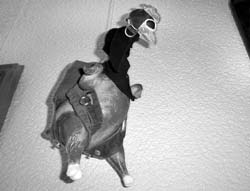Little Wings of A Great Future

The wish to fly is one of the humanity’s eternal dreams. Though it has in fact come true, still it seems somewhat unreal, since the imagination is infinite. Perhaps it is for precisely this reason that this subject is of interest not only for engineers (in terms of various aircraft designs) but also for artists, interpreting the emotional side of anything related to the flights, both in dreams and in reality.
Recall the evidence in literature and cinema of the stormy public reaction to the first aviators’ attempts to take off from the ground to at least a few meters height. This turned all the settled concepts upside down. Not without reason did avant-garde art appear simultaneously with the technological revolution, when artists’ thought also rose to new concepts of color and form.
Disregarding other factors causing the appearance of such artistic phenomena, let us recall how popular the theme of aviation (but not flight) was in the Soviet period. Totalitarianism where possible stressed the power of steel wings, nerves, and muscle.
The new generation of Ukrainian artists also appeared not to be indifferent to realizing humanity’s eternal dream. The more so, because this year marked aviation’s centennial, with our country being far from the worst in this field. In what mood did the artists approach the anniversary? One could get at least some idea of this at the Aviation Day exhibition at the Dim Mykoly [Mykola’s House] Gallery.
First thing that arrests one’s attention on entering the exhibition hall is lack of pretense, which in terms of the fine arts means lack of vividness, grandeur, and pompous paintings. However, there are plenty of works, though not overly large, but quite diverse in technique and inner expressiveness. The figure uniting them all is Mykyta Kadan, the exhibition’s curator, who invited his student colleagues to participate. Thus, the project is the demonstration of a single generation’s stand. Kyseliova’s Aviator sculpture depicts a terrible Kafkaesque figure, a combination of an insect (equipped with the wings of one of the first planes) and a man sporting a turn of the century jacket. Viktor Kharkevych’s Parachute Jumper, a doll hanging on a rope, depicts not a human being but a roast chicken dressed like a paratrooper with goggles, bomber, etc. Kovach’s work presents a collage with a paper plane. Grave seriousness is considered not only a breach of etiquette in contemporary art but also prevents one from adequate perception of the world.
Kadan’s Festival of Aeronautics depicts a family on holiday. The parents almost wring their necks in the attempt to make out a balloon in the sky, while their little boy looks at the viewer, as if wondering in what century he was born. Their tanned yellowish bodies of some undetermined shape, which seem to be coming apart, could perhaps exist completely without thought enjoying the beach.
In Mykhailov’s Monotonous Rhythm of the Seven-Day Week (incidentally, are there any other kinds of week?) the foreground is also full of fidgeting people, with old-fashioned planes with square wings hanging in the sky over roofs. From the outside, this work is a stylization of the 1920s futuristic motifs, however, provoking a certain nostalgia mixed with irony.
The same feelings are aroused by the artistic ornithology, as the curator puts it, meaning the works depicting the plane’s prototypes, birds or even angels (who knows where all this have started). Hnylitska’s The Bird is painted with killing naturalism — a grayish-black winged something that will never take wing. Mykhailov’s red angels are playing musical instruments, obviously to stay closer to heaven. Kolomiychuk’s Windmill, Ruban’s Pumpkin Ball, or Kovach’s Hutsul, perhaps, have no intent to fly, but they add some national coloring to the aeronautical theme, which is also not bad.
While Oborska’s Triptych black-and-white photos are dedicated to the history of aviation, Nakonechna’s color ones are connected with it only by free association. They are saturated with air and sunshine, with light shadows, allusions to a plane or helicopter, flying high in the sky.
The exhibition is interesting in many respects. Judging by the young people’s intentions, they are not aiming to build their future on the basis of some false pretentiousness, but will be as creative as possible in our pragmatic society.






